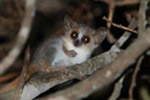The Ecuadorian capuchin, a Critically Endangered subspecies of the white-fronted capuchin (Cebus albifrons), has been discovered in four new locations according to a new study in mongabay.com’s open access journal Tropical Conservation Science. Found only in Ecuador and northern Peru, the scientists say the monkey may be unique enough to warrant consideration as a distinct species.
Surveying eleven forest regions for the Ecuadorian capuchin (Cebus albifrons aequatorialis) between 2002 and 2005, researchers located populations in seven locations, including four private reserves where that had never been documented: Chirije, Hacienda Paraíso, La Hesperia, and Lalo Loor.
Still the scientists “emphasize that the long-term survival prospects of this subspecies remain uncertain, as several of these areas are not officially protected, and hunting and deforestation are problematic even in protected areas.”
The scientists also observed Ecuadorian capuchins in highly fragmented and disturbed forests.
“Our finding that Ecuadorian capuchins uses degraded forest roughly in proportion to its abundance underscores the importance of conserving not only less-disturbed ‘core’ areas of forest that remain in western Ecuador, but also the surrounding degraded and secondary forest areas,” the scientists write, adding that “because Ecuadorian capuchins [are] clearly capable of exploiting a highly varied range of foods and habitats, we believe that if effective protection can be established, there is good potential for these small, fragmented populations to grow and expand into regenerating areas.”
Still, the subspecies, or perhaps distinct species, remains imperiled by deforestation, the illegal pet trade, bushmeat, and harassment by farmers for crop raiding.
CITATION: Jack, K. M. and Campos, F. A. 2012. Distribution, abundance, and spatial ecology of the critically endangered Ecuadorian capuchin (Cebus albifrons aequatorialis). Tropical Conservation Science Vol. 5(2):173-191.
Related articles
Saving Indonesia’s monkey with a heart-shaped bottom

(06/05/2012) North Sulawesi is one of the world’s most beautiful places. Verdant forests and stunning coral reefs, combined with high levels of species endemism, make it a top biodiversity hotspot. But pressure on the region’s natural resources is mounting. Mining projects, conversion of forests for plantations, overfishing, and the expansion of a commercial bushmeat trade is endangering some of Sulawesi’s most charismatic animals, including the distinctive Sulawesi crested black macaque. Found only in North Sulawesi, the crested black macaque could be one of Indonesia’s most iconic conservation symbols, but relatively few people know of its existence. And the locals who do may be inclined to eat it as a delicacy.
New population of Myanmar snub-nosed monkey discovered in China
(05/16/2012) Scientists in China have located a second population of the Myanmar snub-nosed monkey (Rhinopithecus strykeri), a primate that was only first discovered two years ago in Myanmar, also known as Burma. Long Yongcheng, scientist with the Nature Conservancy in China, told the China Daily that his team have discovered 50-100 Myanmar snub-nosed monkeys in the Gaoligong Mountain Natural Reserve near the border with Myanmar in Yunnan Province.
Noel Rowe: all the world’s primates “in one place”

(05/14/2012) Spanning the gamut from mouse lemurs to mountain gorillas, All The World’s Primates is a comprehensive database of primate species. Founded in 2004 by Noel Rowe and Marc Myers and designed primarily to aid scientists and college students in primatology research, ATWP is also readily accessible to anyone who would like to know a little more about primates. The database is continually updated when new species are discovered; from its inception in 2004 until 2010, 58 new species had been added to the site. In addition to discoveries made by primatologists in the field, All The World’s Primates compiles information from the latest genetic studies. The site also includes photos and videos of many species, and was recently expanded to include a visual key for identification.
First camera trap video of world’s rarest gorilla includes shocking charge
(05/08/2012) Ever wonder what it would be like to be charged by a male gorilla? A new video (below) released by the Wildlife Conservation Society (WCS), gives one a first hand look. Shot in Cameroon’s Kagwene Gorilla Sanctuary, the video is the first camera trap footage of the incredibly rare Cross River gorilla subspecies (Gorilla gorilla diehli); listed as Critically Endangered, the subspecies is believed to be down to only 250 individuals.
(05/02/2012) A new study confirms that bigger and stronger silverback gorillas have more success finding mates and raising offspring.